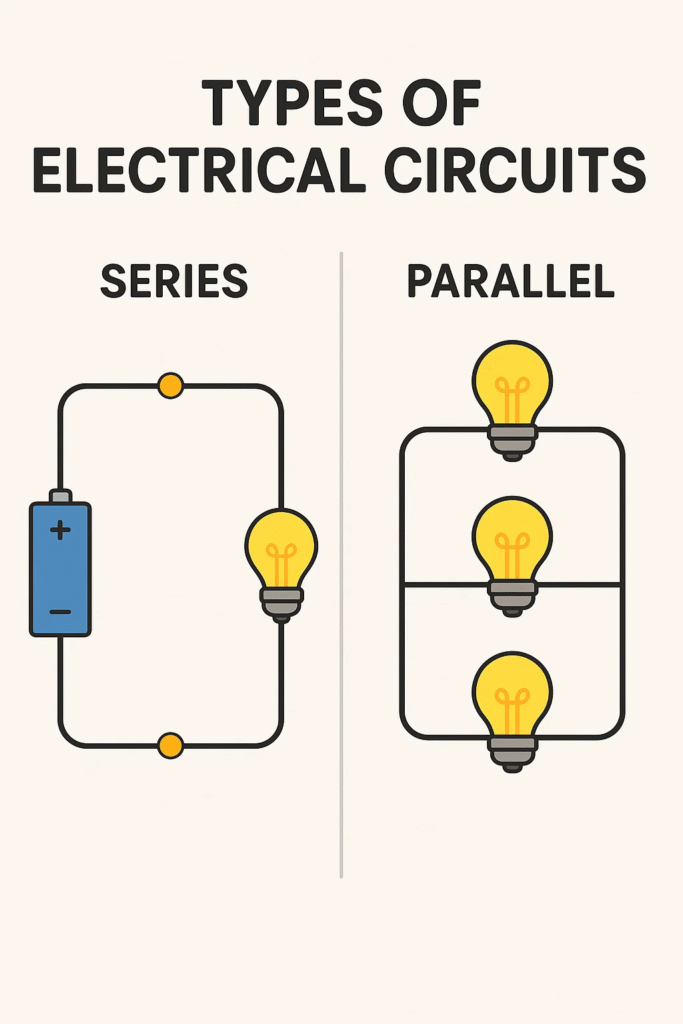Electricity is all around us—powering our gadgets, lighting up our homes, brewing our coffee, and making modern life possible. But how does this invisible force travel from wires to devices? Through something called an electrical circuit.
And while the word circuit might sound a little too “science fair,” the truth is, the concept is actually very intuitive—especially once you break it down into the two most common types: series circuits and parallel circuits.
By the end of this blog, you’ll not only know the difference between the two, but you’ll also understand how they affect your daily life, why your Christmas lights might suddenly go dark, and how your house keeps running even if one light goes out.
⚡ First, What’s an Electrical Circuit?
At its core, an electrical circuit is simply a closed path or loop that allows electric current to flow. It consists of three basic parts:
- A power source (like a battery or electricity from the grid)
- Conducting wires to carry the current
- One or more devices that use the electricity, like bulbs or motors
Without a complete loop, electricity won’t flow. That’s why light switches, which open or close a circuit, control whether a light turns on or off.
Now, let’s look at the two most common ways of organizing components in these circuits.
🧵 Series Circuits: A One-Way Street
A series circuit is like a single-lane road: everything is connected in a straight line, one after another. The same electric current travels through each and every component, one at a time.
🔍 How It Works
Imagine three light bulbs connected in a line. The current flows from the power source, through Bulb 1, then Bulb 2, then Bulb 3, and finally back to the power source. If any bulb is removed or burns out, the circuit breaks—and everything shuts off.
🔦 Real-World Example
Those old-fashioned Christmas lights are a great example. Remember when one bulb went out and the whole string went dark? That’s because they were wired in series. The path was broken, so current couldn’t complete the loop.
✅ Benefits of Series Circuits
- Simplicity: Very easy to design and build.
- Fewer materials needed: You use less wire and fewer connection points.
- Useful for certain safety features: For instance, a fire alarm system might use series wiring, so if one connection fails, the whole system shuts down.
❌ Downsides of Series Circuits
- No backup: If one component fails, it all goes dark.
- Voltage sharing: Components split the total voltage, which can result in lower performance for each.
- Increased resistance: The more devices you add, the harder it is for electricity to flow.
🌐 Parallel Circuits: A Multi-Lane Highway
A parallel circuit gives each device its own personal path to the power source. It’s like having multiple roads branching out from the same source—you can take any road independently.
🔍 How It Works
Imagine those same three light bulbs, but now each one is connected to the battery on its own separate wire. If one bulb goes out? The others stay on because their paths are still complete.
🏠 Real-World Example
Your home is wired using parallel circuits. That’s why when you turn off your bedroom light, the kitchen doesn’t go dark. Each light, fan, or plug has its own pathway to electricity.
✅ Benefits of Parallel Circuits
- Reliable: One device fails? Everything else keeps working.
- Consistent voltage: Every device gets full voltage, so performance remains strong.
- Flexible: You can add or remove components without affecting the whole system.
❌ Downsides of Parallel Circuits
- More complex design: Requires more wires and connections.
- Slightly higher cost: More materials, more work.
- Harder to troubleshoot: If something goes wrong, it can be tricky to trace the problem.
🧮 Understanding the Differences: Series vs. Parallel at a Glance
Let’s compare the two side by side so you can really see the contrast.
| Feature | Series Circuit | Parallel Circuit |
|---|---|---|
| Path of Current | One single path | Multiple independent paths |
| If One Component Fails | Entire circuit stops | Other components still work |
| Voltage | Divided among components | Each gets full voltage |
| Current | Same through all components | Divided based on resistance |
| Resistance | Adds up with each component | Decreases as more branches are added |
| Common Uses | Simple toys, old light strings, sensors | Home wiring, appliances, modern electronics |
🧠 Ohm’s Law in Action
To understand how series and parallel circuits behave, you need to meet a simple but powerful formula:
[ \text{V} = \text{I} \times \text{R} ]
Where:
- V = voltage
- I = current
- R = resistance
In a series circuit, resistance adds up, so the current decreases.
In a parallel circuit, adding more branches reduces total resistance, so current increases.
🔋 Thought Experiment:
You connect a 12V battery to two bulbs.
- Series Circuit: Both bulbs share voltage—each gets 6V, and they’re dimmer.
- Parallel Circuit: Each bulb gets 12V and shines brightly.
🛠 Where You’ll Encounter These in Daily Life
Here’s how both types of circuits show up in the real world:
🧑🍳 Kitchen Appliances
Your microwave, toaster, and fridge all operate on separate parallel circuits. If the microwave trips its breaker, the rest keep running.
🎄 Decorative Lights
Some newer decorative light strings use parallel wiring for reliability—but the cheaper, older ones still use series wiring to cut costs.
🚨 Security Systems
Many security alarms are wired in series so that breaking any sensor shuts the whole system down and triggers an alert.
🔋 Battery Packs
Batteries connected in series increase overall voltage, while parallel connections increase current. Engineers combine both in smart ways for devices like laptops, electric scooters, and backup power banks.
🌱 Why It Matters (Even If You’re Not an Engineer)
Knowing about series and parallel circuits can:
- Help you fix simple electrical problems at home.
- Let you make better choices when buying electronics.
- Prevent frustration when lights go out or devices behave oddly.
- Give you a head start if you ever dabble in DIY tech projects or robotics.
This knowledge isn’t just for electricians—it’s everyday literacy for the tech-powered world we live in.
🎯 Wrapping It All Up
So here’s the deal:
- Series circuits are like a chain—break one link, and it all falls apart.
- Parallel circuits are like a spiderweb—break one thread, and the rest still hold.
They’re both useful. They both have their place. And they’re both part of the invisible electrical language that keeps the modern world glowing, buzzing, and humming along.

Absolutely! Let me add a thoughtful and friendly conclusion to wrap up your blog on Series vs. Parallel Circuits:
🧭 Conclusion:
Electricity, at its heart, is all about connection—and how we arrange those connections shapes everything. Series and parallel circuits may seem like simple patterns of wiring, but they govern how our homes stay lit, how our gadgets run, and even how we troubleshoot when something stops working.
Understanding these two fundamental circuit types empowers you to see the hidden pathways behind everyday life. You now know:
- A series circuit is straightforward but fragile—like dominoes, one break and the whole thing stops.
- A parallel circuit is resilient and adaptable—each part keeps going even if others don’t.
Both systems have their strengths and limitations, and they’re not in competition. In fact, many real-world applications use a blend of series and parallel to balance efficiency with reliability.
